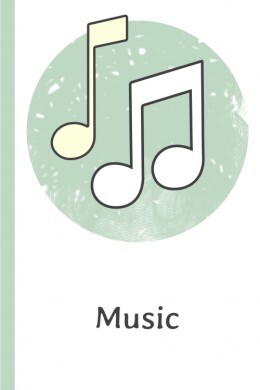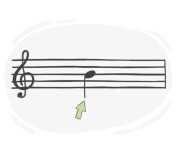Música - Notación musical
Aquí aprenderás algunas palabras en inglés relacionadas con la notación musical como "sostenido", "fermata" y "glissando".
Revisión
Tarjetas de memoria
Ortografía
Cuestionario


redonda
Mientras el director daba la señal, las cuerdas tocaron una redonda, proporcionando una base para la melodía de los vientos de madera.

clave
El guitarrista improvisó un solo en la tonalidad de mi bemol mayor, mostrando su versatilidad y habilidad.

el do central
En la partitura, el do central se indica mediante una línea adicional debajo del pentagrama en clave de sol o encima del pentagrama en clave de fa.

becuadro
El violinista ajustó la entonación añadiendo un becuadro para corregir la alteración.

octava
Las armonías del coro eran ricas con voces mezclándose a través de diferentes octavas.

acorde
La voz del cantante se armonizaba perfectamente con el acorde de piano.

sostenido
El director recordó a la orquesta que estuviera atenta al sostenido en la música para tocar el tono correcto.

blanca
El director le indicó a los músicos que enfatizaran la blanca al comienzo de cada compás.

negra
La línea de bajo proporcionó una base sólida acentuando las negras en cada tiempo fuerte.

tónica
Como director, enfatizó la importancia de la tónica en el establecimiento del centro tonal de la música.

barra de compás
Cada compás en la partitura está dividido por una línea de compás.

clave
El cantante tuvo dificultades para identificar la armadura indicada por la clave, lo que causó confusión durante el ensayo.

tablatura
El bajista confió en la tablatura para aprender la línea de bajo de la nueva canción.

corchea
El bajista añadió corcheas sincopadas al groove, mejorando la sensación rítmica de la canción.

semicorchea
A medida que aumentaba el tempo, el pianista ejecutó el torrente de semicorcheas con agilidad y control.

fusa
El director enfatizó la precisión y claridad de cada treintaidosavo de nota en la actuación del conjunto.

semihemidemisemifusa
Ella ejecutó la serie de sesenta y cuartas notas con claridad y control, asegurando que cada nota fuera articulada nítidamente.

barra
La barra conectaba las notas en la carrera.

tiempo común
La pieza transitó sin problemas entre diferentes compases, alternando entre el tiempo común y los compases de tiempo compuesto.

ligadura
Como cantante, siguió los ligados en la partitura para dar forma a las frases y transmitir emoción.

cuarto de tono
La actuación del cantante presentó deslizamientos vocales expresivos utilizando cuartos de tono para evocar emoción.

alteración
El accidental hizo que la melodía sonara más dramática e inesperada.

arpegio
Los arpegios delicados de la arpista crearon una atmósfera serena y etérea durante la pieza orquestal.

trino
Ella practicó el trino en la trompeta, enfocándose en lograr uniformidad y claridad en la oscilación rápida.

valor de nota
El tempo de una canción dicta qué tan rápido o lento se tocan los valores de nota, afectando la sensación general y la energía de la música.












































